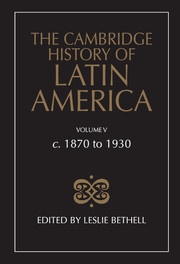Book contents
- Frontmatter
- PART ONE MEXICO
- PART TWO CENTRAL AMERICA AND THE CARIBBEAN
- PART THREE THE RIVER PLATE REPUBLICS
- 9 The growth of the Argentine economy, c. 1870–1914
- 10 Argentina: society and politics, 1880–1916
- 11 Argentina in 1914: the pampas, the interior, Buenos Aires
- 12 Argentina from the first world war to the Revolution of 1930
- 13 The formation of modern Uruguay, c. 1870–1930
- 14 Paraguay from the War of the Triple Alliance to the Chaco War, 1870–1932
- PART FOUR THE ANDEAN REPUBLICSo
- PART FIVE BRAZIL
- Bibliographical essays
13 - The formation of modern Uruguay, c. 1870–1930
from PART THREE - THE RIVER PLATE REPUBLICS
Published online by Cambridge University Press: 28 March 2008
- Frontmatter
- PART ONE MEXICO
- PART TWO CENTRAL AMERICA AND THE CARIBBEAN
- PART THREE THE RIVER PLATE REPUBLICS
- 9 The growth of the Argentine economy, c. 1870–1914
- 10 Argentina: society and politics, 1880–1916
- 11 Argentina in 1914: the pampas, the interior, Buenos Aires
- 12 Argentina from the first world war to the Revolution of 1930
- 13 The formation of modern Uruguay, c. 1870–1930
- 14 Paraguay from the War of the Triple Alliance to the Chaco War, 1870–1932
- PART FOUR THE ANDEAN REPUBLICSo
- PART FIVE BRAZIL
- Bibliographical essays
Summary
TRADITIONAL URUGUAY: CATTLE AND CAUDILLOS
During the decade of the 1860s Uruguay was a nation of no more than 300,000 inhabitants, of whom more than a quarter lived in the principal port, Montevideo, which was also the political capital. The proportion of foreigners was amongst the highest of any Latin American nation. According to the 1860 census one in three inhabitants (and one in two in Montevideo) was foreign: mainly Italian, Spanish, Brazilian, French, Argentinian or British (probably in that order). Uruguay's one railway line, inaugurated in 1869, was only 20 kilometres long. The nation's transport system in fact consisted of little more than primitive tracks; luckily the society's principal product, cattle, had the virtue of being mobile. For the transport of people, carts were used in the east and centre of the country, whereas in the west the use of sailboats and steamships on the Uruguay river gave this region much better communication with the capital. In spite of the small size of the country – about 180,000 square kilometres – travel in the interior was slow, especially in winter when the swollen rivers and streams blocked land routes. At such times central government, landowners and traders alike seemed more to be living in a medieval backwater rather than in a nation of the modern world, in the second half of the century of the steam engine.
The economy was based on the extensive exploitation of native (criollo) cattle. Their heavy hides were shipped to Europe, while part of their thin flesh, after salting and drying in the saladeros (meat-salting establishments) to become tasajo (jerked beef), was consumed by the slave populations of Cuba and Brazil.
- Type
- Chapter
- Information
- The Cambridge History of Latin America , pp. 453 - 474Publisher: Cambridge University PressPrint publication year: 1986
- 2
- Cited by



